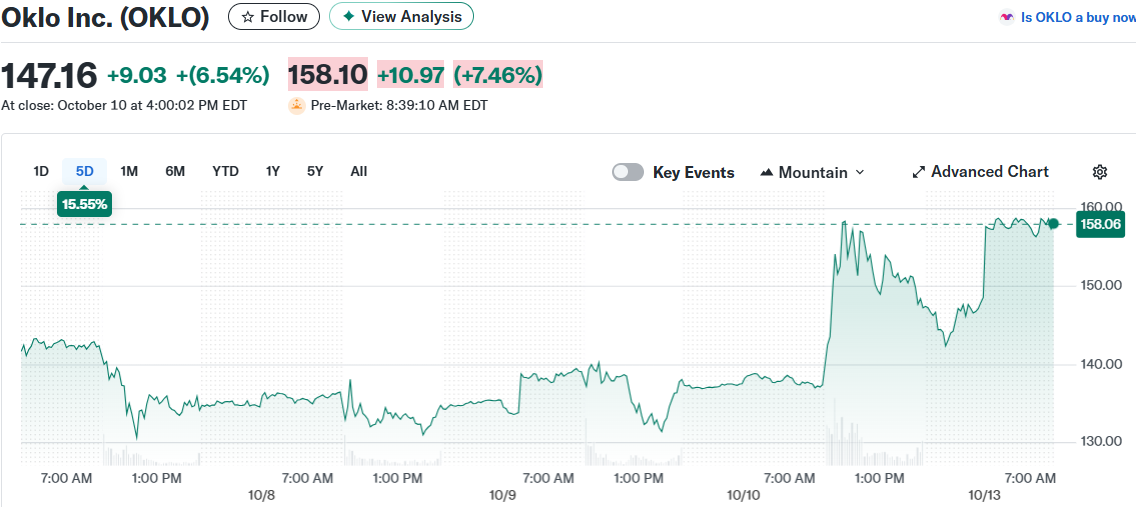TLDR
- Oklo stock has surged over 1,000% in the past year, trading at $147.16 with a $20 billion market cap despite generating zero revenue
- Canaccord Genuity initiated coverage with a buy rating and $175 price target following the Department of Energy’s selection of Oklo for its Advanced Nuclear Fuel Line Pilot Project
- The company designs small modular reactors for data centers and industrial sites, positioning itself in the AI power demand market
- Oklo went public via SPAC in 2024 and faces potential shareholder dilution as it needs more capital to fund expensive reactor development and regulatory approvals
- The stock trades more on narrative momentum than fundamentals, with critics comparing it to meme stock behavior rather than traditional investment
Oklo stock gained 6.5% on Friday, closing at $147.16 as the broader market declined. The nuclear energy company has delivered a 1,130% return over the past year.

The rally follows Canaccord Genuity’s Tuesday initiation of coverage with a buy rating. The investment bank set a $175 price target on the stock.
The timing coincides with the Department of Energy’s selection of Oklo for its Advanced Nuclear Fuel Line Pilot Project. The program will see Oklo build and operate three fuel-fabrication facilities to support advanced reactor deployment.
Oklo designs and develops small modular reactors for data centers and remote industrial sites. The company targets the growing power needs of artificial intelligence infrastructure. Wall Street estimates this market could reach $10 trillion in value.
Revenue and Profit Picture Remains Empty
The company currently generates no revenue. It has no profits either.
Oklo went public through a SPAC merger in 2024. Its market cap now stands at $20 billion, matching the valuation of mature energy companies with established cash flows.
This disconnect raises questions about sustainability. The company will likely need additional capital to fund reactor construction and navigate lengthy regulatory approvals.
Management may pursue a secondary stock offering while shares remain elevated. This would provide needed funding but dilute existing shareholders. Building nuclear reactors requires massive capital investment that can take years to materialize.
Partnership Strategy Takes Center Stage
The company’s 2026 path will likely focus on announcing partnerships rather than reporting profits. Expect collaborations with government agencies and private enterprises seeking alternative power sources.
Data center operators and cloud computing giants represent potential partners. These deals generate headlines but don’t produce immediate cash flow.
The deals offer future optionality without near-term financial impact. Oklo remains years away from deploying and operating a working reactor at scale.
The Department of Energy has provided early support for the company’s technology. However, transforming this support into commercial operations presents challenges.
Regulatory approvals can extend timelines significantly. The capital-intensive nature of nuclear development compounds these obstacles.
Critics argue the stock behaves more like a meme stock than a traditional investment. Online forums have embraced Oklo as the next frontier in nuclear innovation.
The valuation appears driven by speculative optimism rather than measurable results. This pattern resembles dot-com era stocks valued on engagement metrics instead of fundamentals.
Day traders have found fertile ground in the stock’s volatility. Retail hype rather than institutional analysis appears to drive price action.
Some analysts warn that the current valuation defies gravity given the lack of revenue. The company has yet to deliver a prototype demonstrating compelling unit economics.
The Department of Energy’s pilot program selection provides validation for the technology approach. The three fuel-fabrication facilities represent concrete steps toward commercialization.
Oklo’s position in the AI power market offers legitimate long-term potential. Data centers require massive amounts of electricity to operate. Small modular reactors could provide reliable baseload power.
The stock closed Friday’s session up $9.03 despite weakness in major indexes. Trading volume reached 747,901 shares against an average of 19.6 million.
Shares have traded in a 52-week range of $9.01 to $161.41. The stock hit its all-time high earlier this week before pulling back.
Stay Ahead of the Market with Benzinga Pro!
Want to trade like a pro? Benzinga Pro gives you the edge you need in today's fast-paced markets. Get real-time news, exclusive insights, and powerful tools trusted by professional traders:
- Breaking market-moving stories before they hit mainstream media
- Live audio squawk for hands-free market updates
- Advanced stock scanner to spot promising trades
- Expert trade ideas and on-demand support



